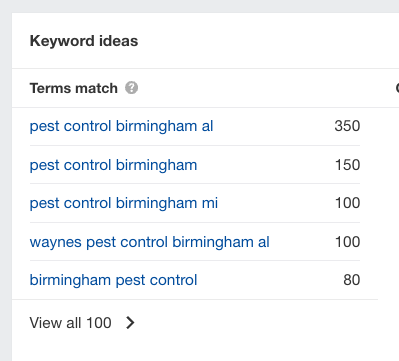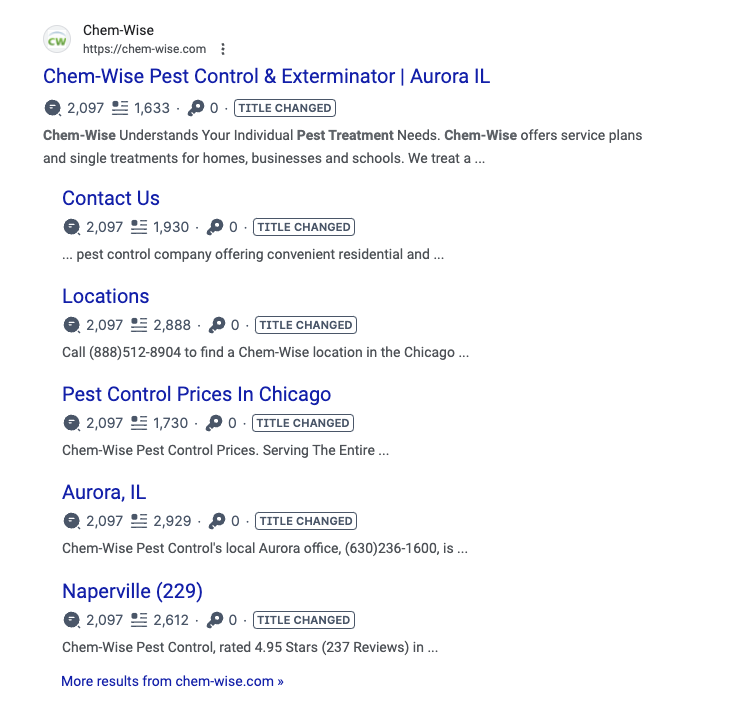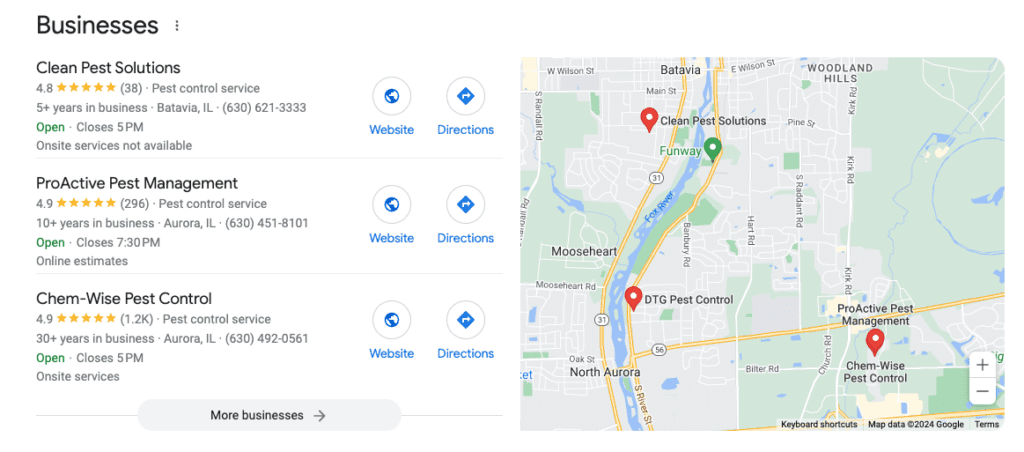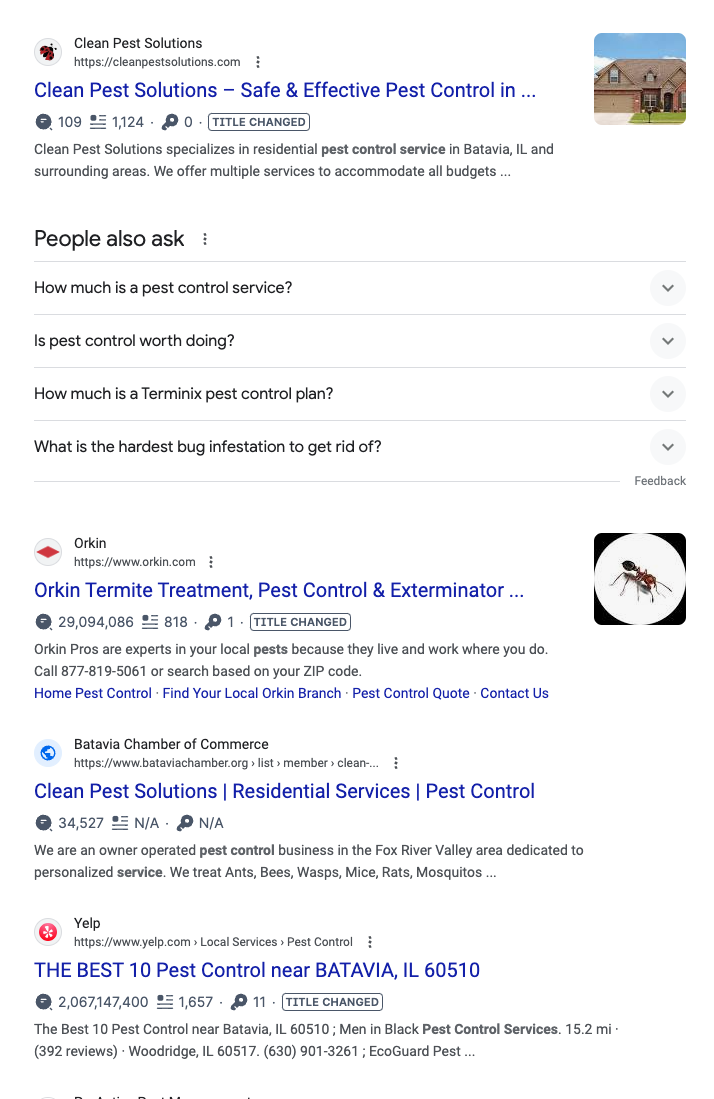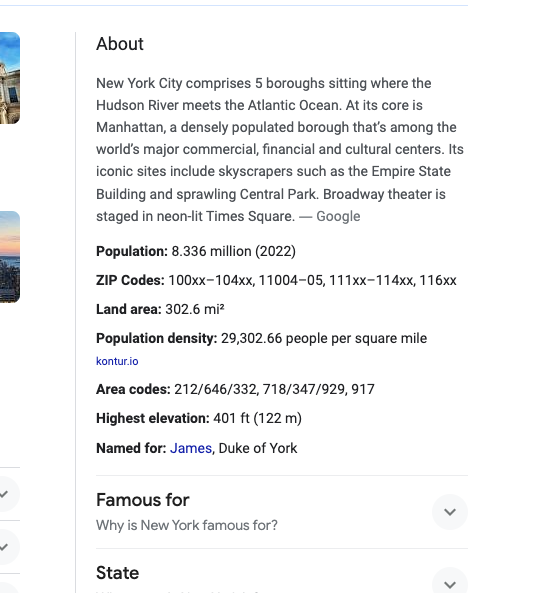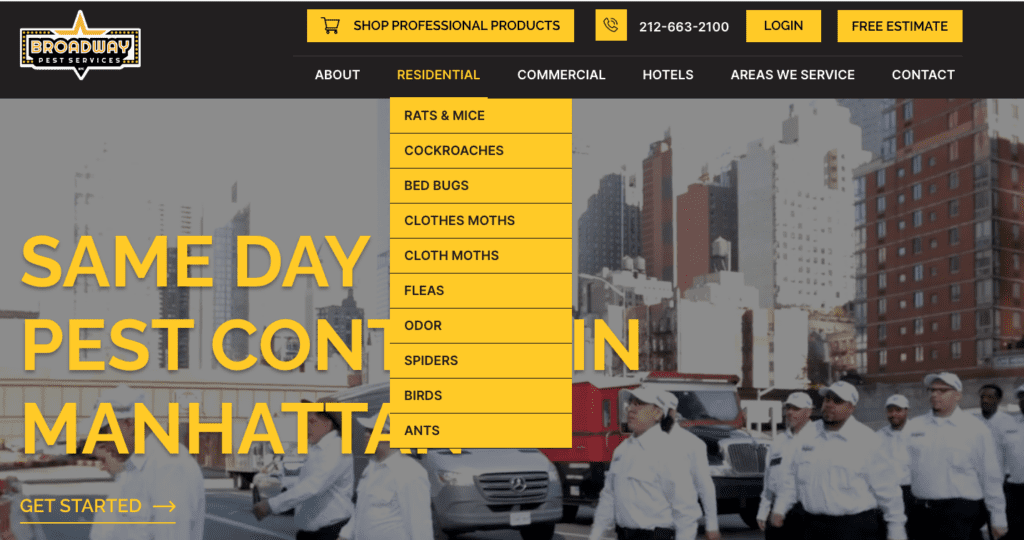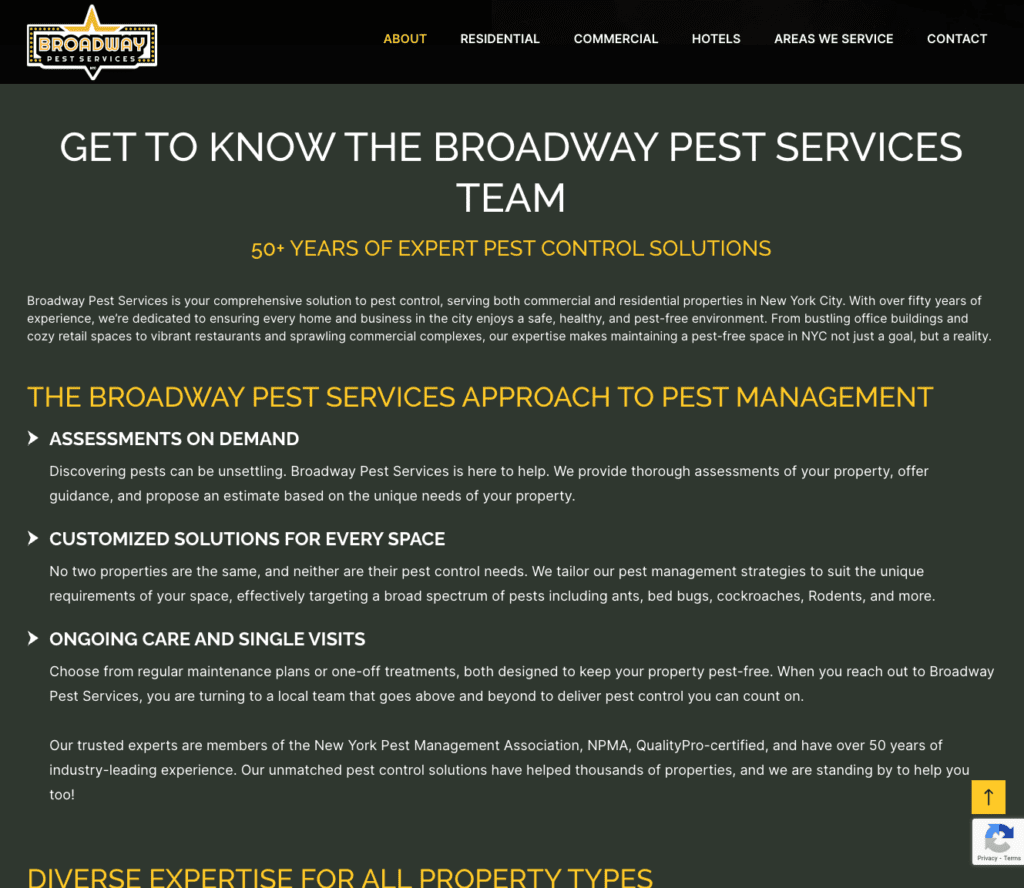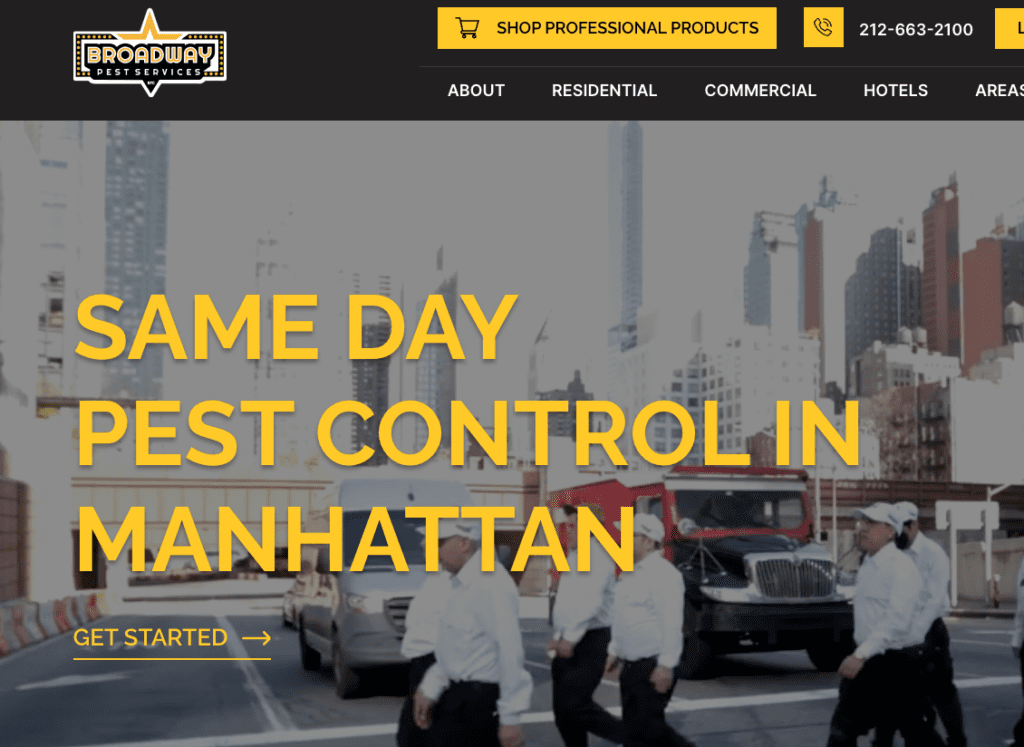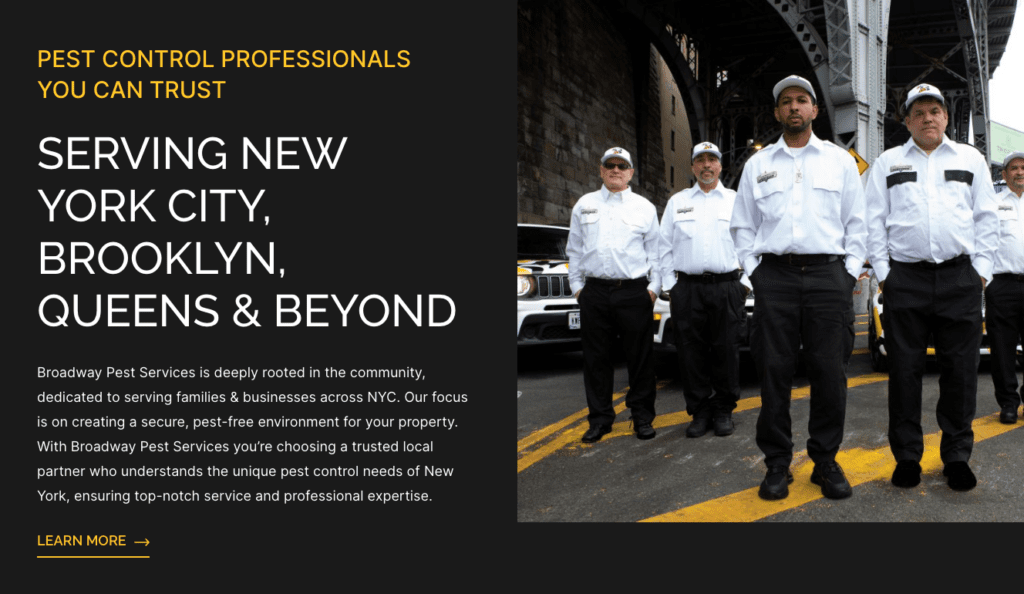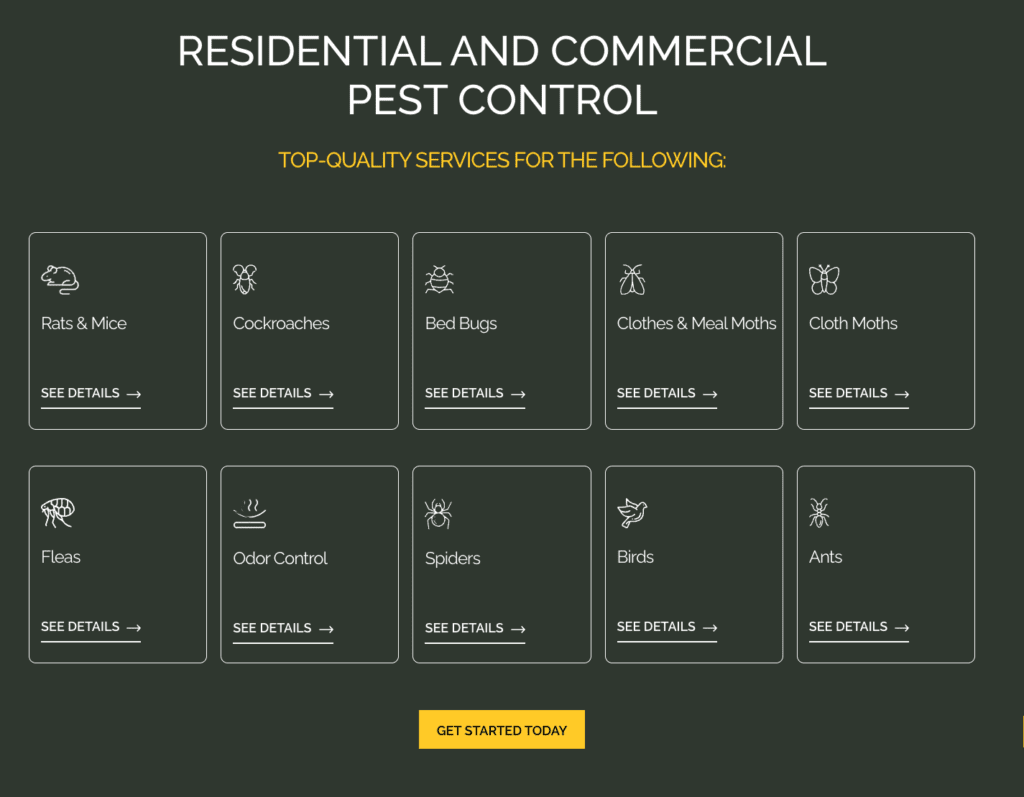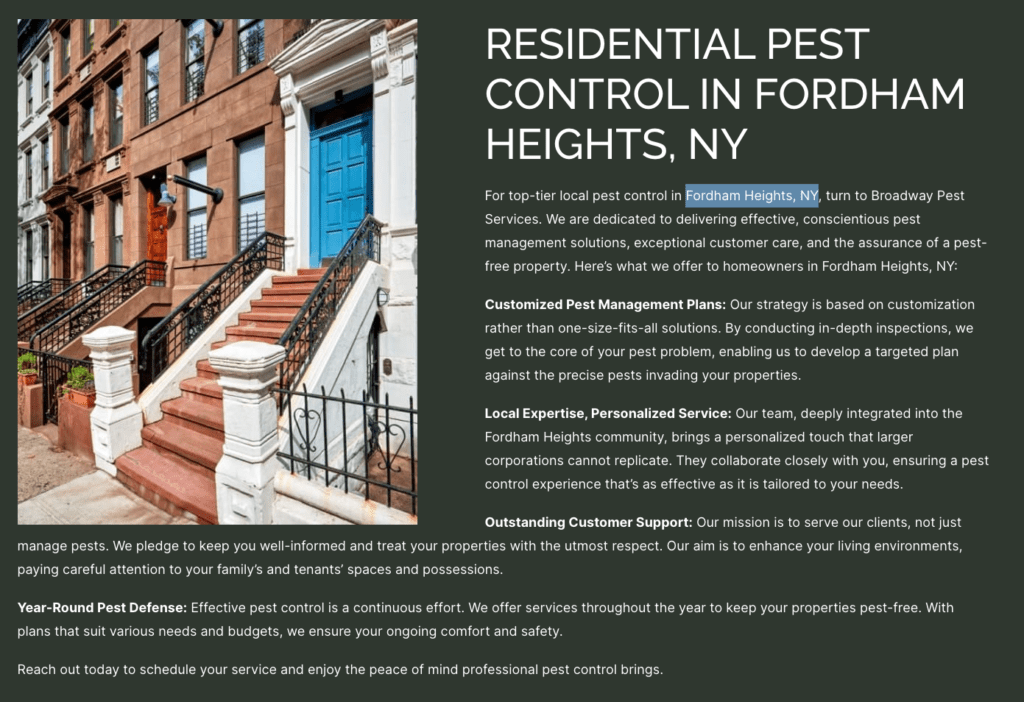Table of Contents
Local service providers power local communities—from window washing, gutter cleaning, house painting, and other contracting services. These local entrepreneurs support local communities’ needs. Pest control services are no exception. “Pest control SEO” is the act of gaining search presence and visibility for your local pest control company in Google SERPs (Search Engine Results Pages).
Key takeaways
- “Pest Control SEO” is the act of optimizing pest control service websites for their presence in Google’s search engine results pages.
- Many pest control SEO campaigns fail to look at the domain’s overall authority as a factor that’s contributing to the lack of success for the service provider.
- Creating key supportive pages can increase a pest control company’s SEO authority by ensuring that they have designated pages around their residential and commercial offerings, the service areas they service, and the specific insect or rodent issues they help resolve. As a byproduct, creating entity (or embedding/vector) relationships across multiple pages under a single domain.
Keyword research and your pest control SEO targets
The primary objective of most pest control SEO is to fill a gap between customer demand and your offering whether it’s a service, product, directory, or some other type of business opportunity. Where most fail with keyword research is that they lean a little too heavily into the keyword. Rather, use it as a guide to understand how your target customer might find you. And how you can get a target page that you have in front of them.
According to a study by WebFX, “46% of Google searches are looking for local businesses.” And according to DemandSage, over 8.5 billion searches happen on Google every day. For those who might be thinking that “SEO” isn’t an ideal acquisition channel to invest in, the data would suggest otherwise.
Here are a few target keyword types that you might want to consider for your pest control company. A favorite tool to use for all keyword research is Ahrefs. Below, I’m going to include screenshots of those terms I discovered while thinking about offering pest control services in the Birmingham, AL area.
Related: 100 Pest Control Keywords for SEO
1. “Pest Control Near Me”
“Near me” pages are often linked to city and state pages. Most people fail with their pest control SEO endeavors by “over-optimizing” for keywords rather than over-optimizing for the customer journey. In fact, much of Google’s latest quality rater guidelines suggest that they’re looking for their teams to try and optimize the best web experience for Searchers rather than find or discover the most relevant pages. Tip: If you’re curious about what and who the “quality raters” are in Google, this is a wonderful resource on the task this team has in front of them.
I’ve seen homepages with meta titles (or page titles) that say things like, “Pest Control Services Near Me | Birmingham, AL”. It’s best to avoid that type of over-optimization in modern pest control SEO. It’s usually a key signal to Google’s rank systems that a page could be “spam potential.” Rather, like mentioned above, align your SEO strategy with the best customer experience. Google’s perspective could be, “We have enough pages to choose from, which is the best page to choose?”
When wanting to go after your “near me” terms, consider adjusting and targeting your homepage to these “near me” searches.
As an example, some of the most common pest control SEO best practices that a homepage might lack are:
- A lack of the city or state name in the meta title: If your page title is “Joe’s Pest Services,” Google is going to have a harder time creating a geospatial understanding of that page. Instead, choose something like, “Joe’s Pest Services | Birmingham, AL | Call Us Today!” A reference to the city and state in the homepage’s meta title will (at least in 2024) start to give you a presence for nearby customer demand and lead generation.
- Failing to include target geographies in meta descriptions: While a meta description is no longer told to be a ranking factor, it does present another data point for the BERT engine to determine relevance. It’s an easy win to adjust your meta description over adjusting content on your homepage.
We’ll get more into your tactical optimization of these pest control service keywords shortly…
2. “Pest Control in [City/State]”
Just like with “near me” searches, you’re probably going to want to target specific city and state demand. Keywords like, “Pest Control in Birmingham” or “Pest Control in Birmingham AL.” If you’re a larger service provider, however, you may have multiple service areas that you serve.
And this should adjust the way that you think about your pest control SEO strategy. As an example, we suggested above that your homepage would target your “near me” searchers. However, if you have multiple cities that you serve, it’s probably best to create individualized pages that speak to your service areas.
Ahrefs and other tools may lack giving you great visibility into the cities that have search volume. However, don’t completely rely on Ahrefs or SEMrush for this.
You might come up with a list that looks like this:
- Pest Control Birmingham AL
- Pest Control Tamworth AL
- Pest Control Coventry AL
As a result of these keywords, your top-level navigation may change and as a byproduct, the very healthy internal linking structure comes along with it. For example, a top-level navigation dropdown that says something like “Service Areas” with each individual service area page being designed to target those ideal customer personas.
Here’s an example of Chemwise playing out this exact SEO strategy for their pest control services:
We can see a few page titles ready to optimize to further their strategy forward, as well. Note: Naperville (229) which appears to be a phone number, however, not being loved by Google.
3. “Pest Control in [Neighborhoods]”
Similar to the above, another strategy for keywords that is often overlooked is the application of neighborhoods as a target for your pest control services. Usually, tools like Ahrefs will show very small volumes of monthly search presence for these types of keywords.
However, building neighborhood service pages only for extremely large cities (like New York City, Los Angeles, or Chicago) can certainly help in getting demand from those who might be looking for same-day services or emergency pest control services.
Avoid doing this if you’re not in a large city. Mostly because there simply won’t be any purpose for your effort. You’ll need to consider whether neighborhood names make it part of the regular vocabulary. For example, “West Village” (New York City) would be a good one to consider. However, some boroughs are also thought of as cities.
In that case, you might have something of a pest control website structure as something like this:
- Homepage: Pest Control Services in New York City
- Service Page: Pest Control Services in Manhattan, NY (Borough)
- Service Page: Pest Control Services in Brooklyn, NY (Borough)
- Service Page: Pest Control Services in West Village, NY (Neighborhood)
These supplemental service pages give you the right page targeting for your campaign.
Before we get into how to begin optimizing your pages and website for these target terms, let’s talk about a few foundational components that will increase your chances of success…
GMB listings and your brand’s foundation
There’s no avoiding this fact, when your pest control customers start their local service search journey, they’ll be immediately slammed with the “Businesses” panel that shows up in Google. This is often called “GMB” or “Google My Business.” These are the GMB listings that will most likely receive most of the first-clicks from Searchers:
Because of this, you’re really targeting your SEO strategy around targeting the “first clicks” that happen after the scroll of local businesses:
It’s important to make sure that you do have a presence in that “Business” panel listing (GMB optimization). And here’s the main reason: your GMB optimization helps your organic SEO efforts. Let me explain…
1. Real people with real reviews
“Gaming” GMB reviews is quite a difficult task (and never recommended). Google has done a tremendous job of ensuring that very little spam is available in GMB reviews. Because of this, they’ve utilized some of these reviews to draw connections between entities (more on that soon, think of an “entity” as a noun — a person, a place, a thing).
The real reviews of real people act as a type of “brand mention” very similar to the effect of earning a backlink. These brand mentions, think of a review like, “Using Pete’s pest services was really amazing. I appreciated everything they do for the Birmingham area” gives a lot of clues for Google’s rank systems to put weight toward your overall authority (site authority or domain authority).
In fact, you can see this sometimes when you Google certain services and the BERT engine decides to bold certain keywords in the User reviews.
2. History of your pest control company in Google’s results
Thinking about “reputation management” or optimizing your Google My Business presence can also help to draw connections between your entity and your website. For example, your Google My Business listing should have:
- Accurate business hours
- Accurate phone number
- Accurate business address
- A linked website URL
- A linked phone number to call
When these data points are also present in your global footer or top navigation it creates a nice relationship with the GMB profile and your business. This relationship helps Google to connect any additional dots that might be available. For example, the length of time that you’ve been in the pest control business.
You’d be surprised at how some of these factors are being considered in the overall potential to rank your website for your target keywords.
3. Real (and unique) photography of you and your pest control service employees
Similar to how phone numbers, social media profiles, and other “validating” information can be connected to your GMB profile and the website, this can be done through photography, too. An “About us” page might include pictures of your team. Or real pictures of your service members.
If you place stock photography inside these listings, there’s a chance that this “less unique” photography not only does a disservice to your CTR (Click Through Rate) but also the overall call rate.
4. Because people do click on GMB listings!
There’s just no avoiding the fact that there are a lot of clicks that happen on those GMB listings. Especially on mobile. And when thinking about your SEO strategy, it’s best to think about it holistically. As a channel in addition to all the other marketing channels you have and how they play a role together. Many businesses who are just solely focused on SEO actually have a more difficult time getting traction than those who are adding pest control SEO as an acquisition channel into their marketing tactics.
Foundational pages, your topical authority, and what you might be missing in your pest control SEO approach
Aside from simply ranking target pages to target keywords (i.e., “pest control services in Birmingham AL”), there’s usually a miss when it comes to service providers’ websites and why they’re not performing.
I mentioned I would start to speak about entities. A simple way to think about this is persons, places, or things. When you search on Google, they often know that one thing has a relationship to many other things. For example, if you search New York City, they’ll know population size, zip codes, and other key information about the geography. FatJoe does a great job of explaining it, “An entity in SEO is a record on a search engine database that represents something. An entity can be a person, place, product, event, idea, or brand. Google defines an entity as ‘a thing or concept that is singular, unique, well-defined and distinguishable.’” We’ll get into why that’s important in a moment…
Just to give you a visual for this concept, you can see these entities appear in the SERPs in this example when searching New York City:
These relationships are often referred to as vectors, embeddings, or “entities.” For the sake of this article, I’ll refer to them as entities.
So let’s say we’re discussing pest control. Then there are some potentially aligned entities that we can think about. The directory might go as follows:
- Animals and Insects:
- Rats
- Mice
- Bed Bugs
- Cockroaches
- Fleas
- Spiders
- Ants
If I were to ask you, “What types of insects and animals would you consider to be pests?” You would probably come up with a list very similar to this. And then if you were to ask an expert on the street, “What types of insects and rodents are considered to be pests in the area?” They should be able to recite a list very similar to this as well, right?
And that’s the concept and purpose behind this whole “entity” and “entity SEO” thing…
The way that Google’s engines are beginning to work is by looking at entity presence and relationships across multiple pages of an overall domain. And then using that as a scoring mechanism for the entire website to give it that “authority” status.
In short, this gives them the ability to put higher-quality websites higher up on the search results. Pages that are “from experts.”
This is how it plays out for you on the other end of this as a Google Searcher. Let’s say were a prospective pest control customer or lead, you’re probably going to want to look into whether the company you’re about to call can actually service the type of rodent or insect issue you have (i.e., a mouse problem, a rat problem, etc.) Voila, the website you’ve landed on addresses those questions!
We can see this exact type of “entity SEO” play out with Broadway Pest Services in New York City. They rank #2 for “pest control in Manhattan” and this is what their top-level navigation looks like:
We can see individual pages that speak to these “entities” and have unique, insightful, and helpful content on each of these individual pages. In addition, they interweave between each other using a clear internal linking strategy.
For many business owners looking to optimize their SEO presence, they might not be considering these internal or lower priority pages as important to their SEO campaign. However, they should be!
1. Service pages and topic coverage
Very similar to having specific service pages that align with our “entity SEO” approach, individual city pages have the same effect. A general rule of thumb is to create a service page and internal linking structure of your website that properly reflects your subject matter expertise for pest services.
For example, if you’re in Arizona, you might include “scorpions” as a service page. Not only does this do a service for any searchers who are looking for something like the following:
- Scorpion Pest Control in Chandler AZ
It also provides you with authority around this type of keyword, too:
- Pest Control Chandler AZ
The key difference is merely the target page you’re using to focus in on these keywords. Think of it as a pretty simple best practice:
- Homepage: Should always target your “top-level” keyword. Things like “Pest Control in X” (which will also target any “near me” keywords).
- Service Pages: Targeting local specific rodents or insects, like “scorpions,” “ants,” or something else.
- City and Local Pages: Targeting a specific city, borough, or neighborhood pending your service area coverage.
You can see this very same strategy playing out with Broadway Pest Services as well. Their inclusion of “Service Areas” in the top-level navigation gives Google’s engines everything it wants to know.
Is the website authoritative around the subject it speaks to? (EEAT) In the quality rater guidelines, “The authoritativeness of the creator, the main content itself and the website.”
We can see that the answer is yes! And here’s how Broadway Pest Services did it:
Why don’t more pest control companies do this when thinking about their SEO strategy? Generally, most SEO campaigns begin with a keyword. And that’s an older way of thinking about SEO. Thanks to the improvements Google’s made to its engines, we have to think more holistically about our website experience and authority and ensure that we’re providing Google with both target pages that aim to meet specific keywords and indirect pages that don’t target keywords and rather, target authority.
2. “About us” pages
Very similar to service and city pages, “About us” pages give Google’s engines even more understanding of the overall authority of the publisher of the website. These “About us” pages are often forgotten about as part of the core strategy for service provider pages. Why is that? Generally, the assumption is that Search visitors aren’t going to an About page.
And while that’s most likely true, these types of pages still hold a lot of value for Google’s engines to help increase overall site authority.
Here’s another great example of this by Broadway Pest Services:
We can see phrases like “50+ years of expert pest control solutions.” When I think about Trust or Authority (per Google’s EEAT factors), phrases like this really stick out to me. In addition, a “customer promise” that appears on the page is another way to really speak to Trust.
If you were shopping on an e-commerce website and it didn’t have any pages that speak to its refund policy or product guarantee are you going to potentially better or worse experience with that brand? There’s a greater chance that it will be a worse experience than a brand that prioritizes telling you about their refund policy.
The same thing applies to an “About us” page. It’s your opportunity to show passion, trust, authority, and security in what you provide. And Google’s engines (while we don’t know the exact percentage) certainly take these things into consideration.
Pest control SEO best practices to target your ideal keywords
If you’ve gotten all the way down here, then you’ve made it past the newer concepts regarding Google’s analysis of all of your pages under a given domain to give it authority (that will help it perform the best). However, what are some of the basics to look for? Many GoFish clients have some missing best practices that don’t give them the best shot of being performant. Let’s use our example website, Broadway Pest Control, and break down what they did well when it comes to their “pest control SEO” efforts:
1. Presence of their target keyword in the H1
Often overlooked and simple enough. Ensure that there’s a presence of your target keyword for the page intent type in the H1:
We can see the presence of “pest control in Manhattan” as part of their headline.
Read more: Improve your pest control company website for SEO
2. Not over-optimizing what they offer for SEO
Injecting “pest control in Manhattan” over and over again into the page is just going to trigger some of the spam controls Google has in place (yes, there are obviously systems to prevent spam from appearing in SERPs).
Broadway Pest Services does a great job of thinking about what questions the customer has. And how to properly address those questions. Yet, including small adjustments that mention locations that they service. Making them relevant to their target keyword.
In short, think about your H2’s and H3’s. These are simple areas to add some relevancy to your page. These minor adjustments won’t trigger those age-old “keyword stuffing” tactics that are “long gone” in the world of SEO.
3. A helpful internal linking strategy
For someone dealing with a particular problem, there’s an individual service page that addresses each of these issues. In addition, a clear and well-designed internal linking strategy that connects these pages together (once again, creating that site or domain authority that Google prefers).
We can see a well-designed way to learn more about all the types of insects, bugs, and rodent problems that the company services.
4. Helpful and relevant paragraph text on internal pages
It’s a fairly common mistake to think about “unique content” as being something other than what the customer is looking for. For example, a common tactic when targeting city or state local searches is to describe the city or the state’s facts or figures (like their population, average income, and facts about the cities history). However, that’s not relevant content to include on the page.
Broadway Pest Services does a great job of speaking to their services in the area and including their target terms (i.e., “Fordham Heights, NY”) without it becoming irrelevant text. For example, think if you went to look for a birthday cake recipe and were being told the history of eating with forks. It’s just simply not what you’re looking for.
Keep all of your page content relevant AND optimized for your target audience and keywords. However, don’t overdo it. Think about the common questions that someone wants to know when investigating your services and answer them (and no… that doesn’t mean including FAQs at the bottom of the page—try to integrate answers to the common questions throughout the entire page itself).
Other things potentially impacting pest control SEO performance
I’ve spoken a lot about some rather “new” strategies here. However, these ones are certainly being embraced more widely already. And have great supportive evidence for showing that they work.
However, it’s important to note that if you’re not seeing success with your campaign, a few other reasons could be:
- Technical SEO: Is your HTML up to par? Simply put, technical SEO audits can help to ensure that Google’s crawlers are properly picking up your page content. And if they can’t properly pick up your page content, then there’s very little chance that the automated engines can assess what I spoke about above. Make sure that you have a foundation to build on. Do you have a properly formatted XML sitemap submitted to Google? Are all of your pages indexable? These basic questions can go a long way in eliminating the “guessing game” of SEO (as it sometimes can feel).
- Reputation Management: If you have a brand new service offering in the area. Then you’re not going to have as many reviews of your business. Or mentions of your business. This could be acting as a type of “backlink” strategy that you don’t really have. It’s important to consider how building reviews, ensuring your GMB listing is optimized, and the overall length of time that you’ve had customers (especially if you’re new) is having an impact on your SEO campaign.
- Search Intent: If you’re writing blog posts and hoping to target keywords like “Pest Control in Birmingham,” you’re probably not going to do very well. Google has a great way of determining this. Stamford Digital does a great job of summarizing this. Saying, “Google knows when a user carries out a search and doesn’t find what they are looking for. They get a signal sent back each time this happens, and it is these signals that help the search engine giant understand that the intent and results are likely mismatched.” Relevance, User satisfaction, and lower bounce rates play a role here. If a User lands on your “blog post” page and expected to see a service page, this would send them back to Google, creating a negative “point” for the page to Search match. In short, make sure that you know what these page intent types are and how your search queries align with them.
GoFishDigital is happy to help pest control companies with their SEO, reputation management, and local listing campaigns. Request an RFP today.
Search News Straight To Your Inbox
*Required
Join thousands of marketers to get the best search news in under 5 minutes. Get resources, tips and more with The Splash newsletter:
